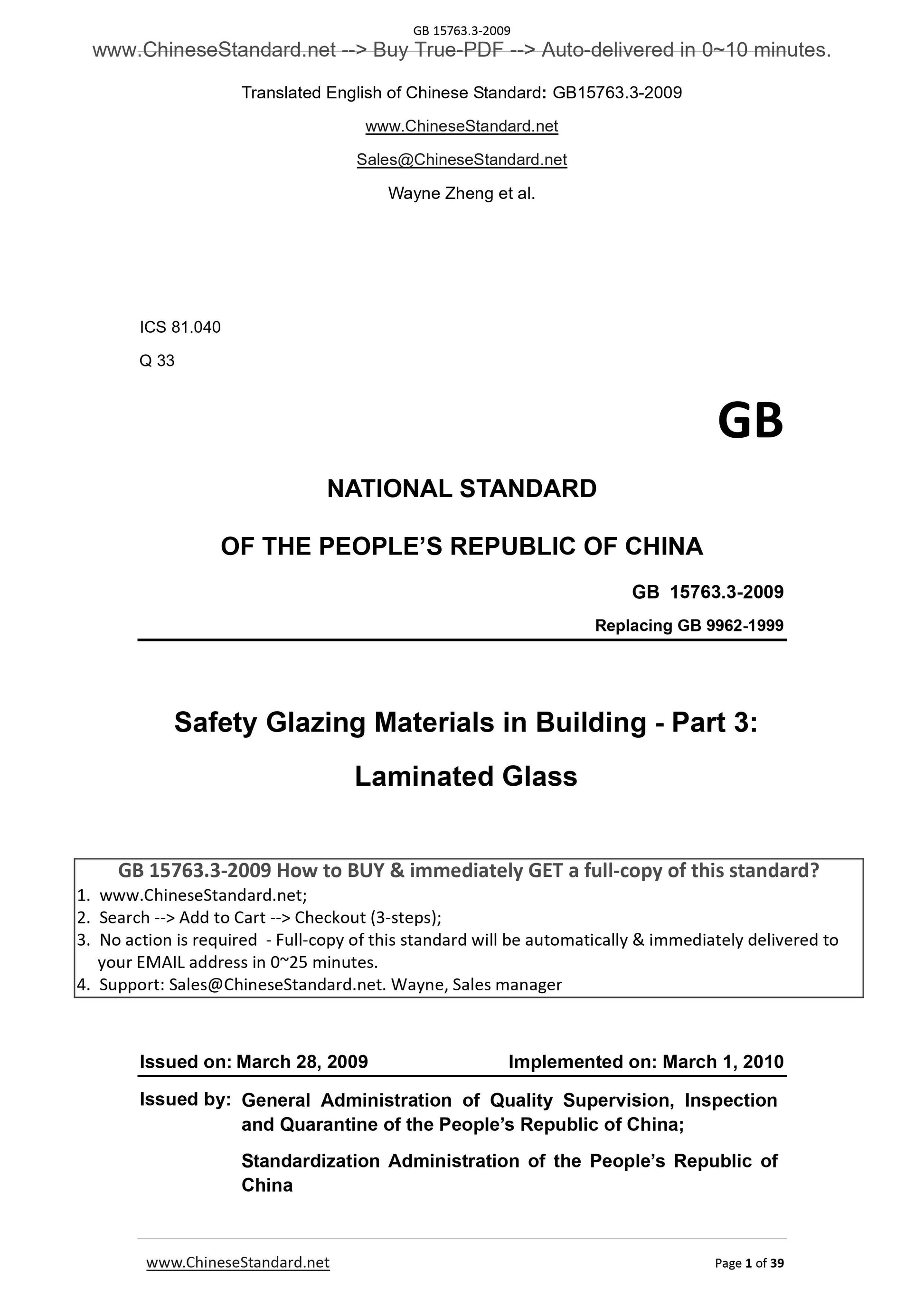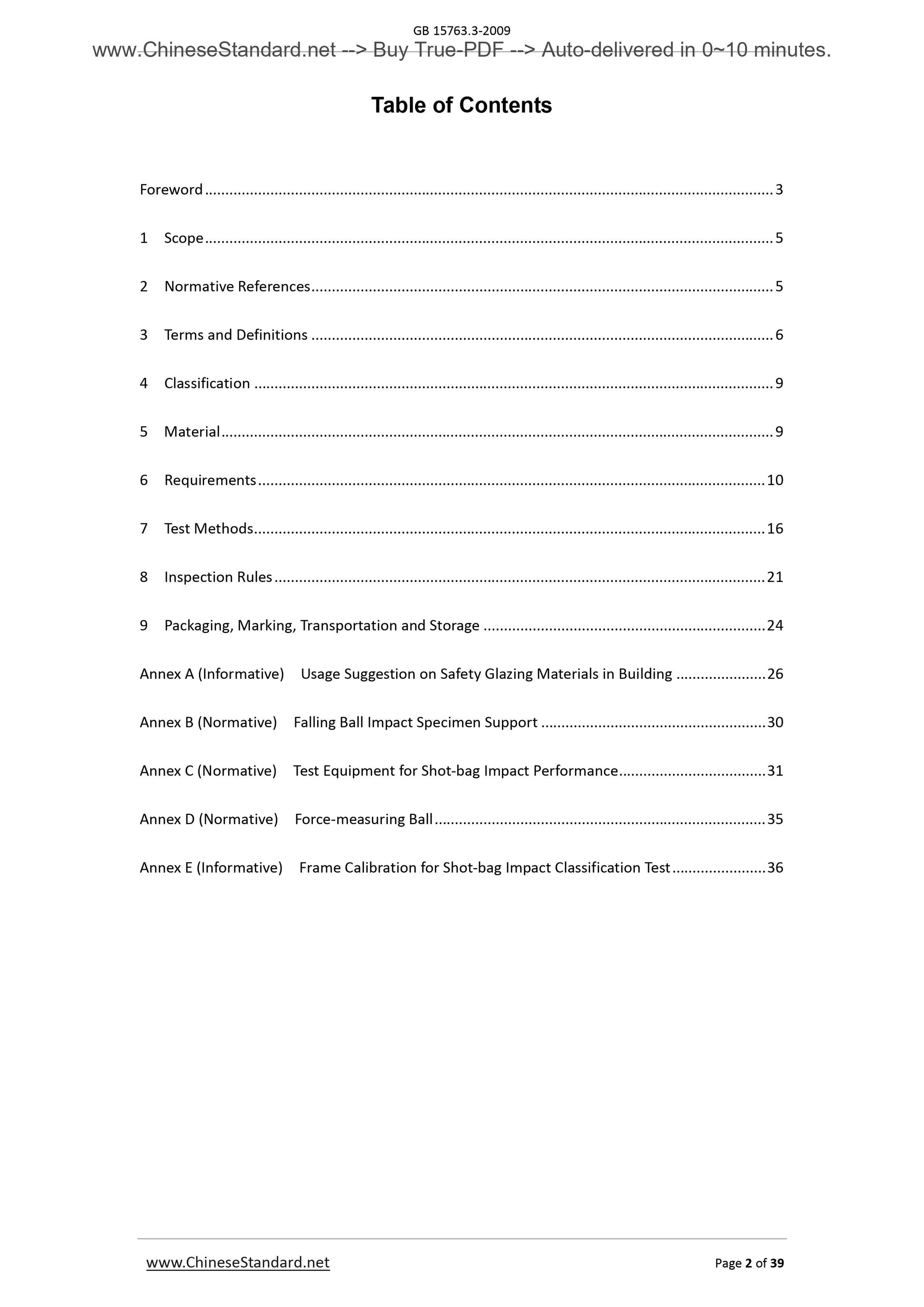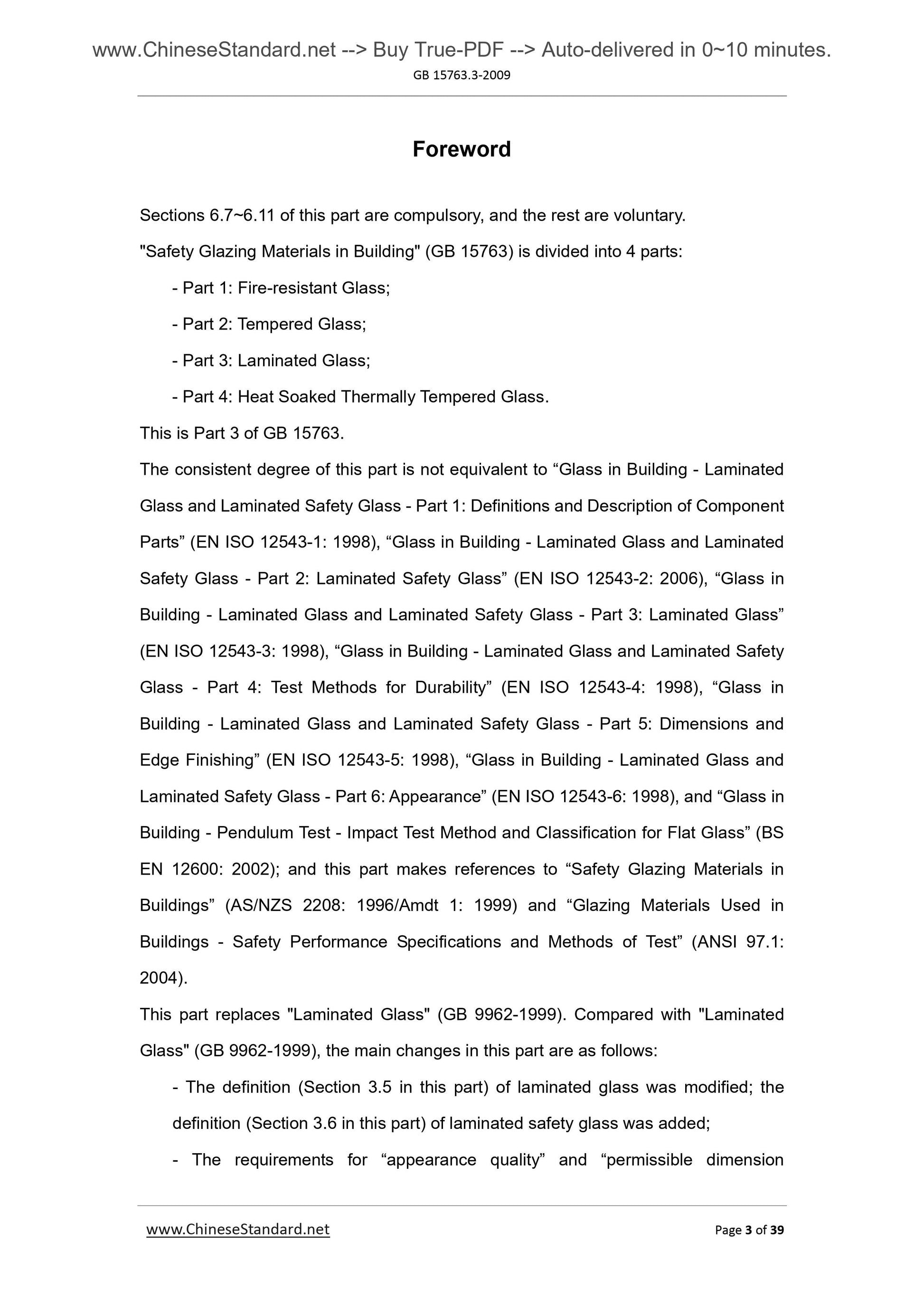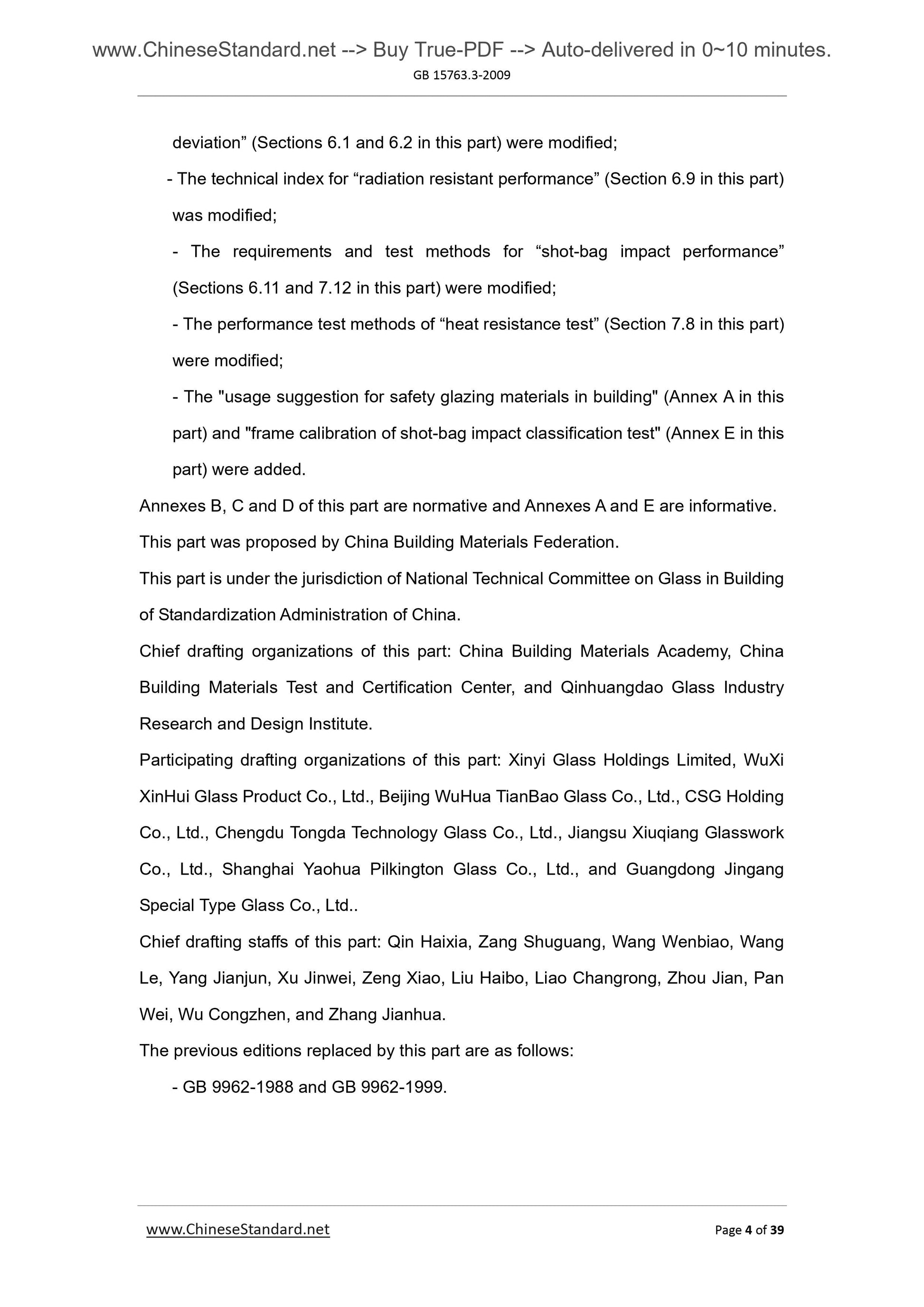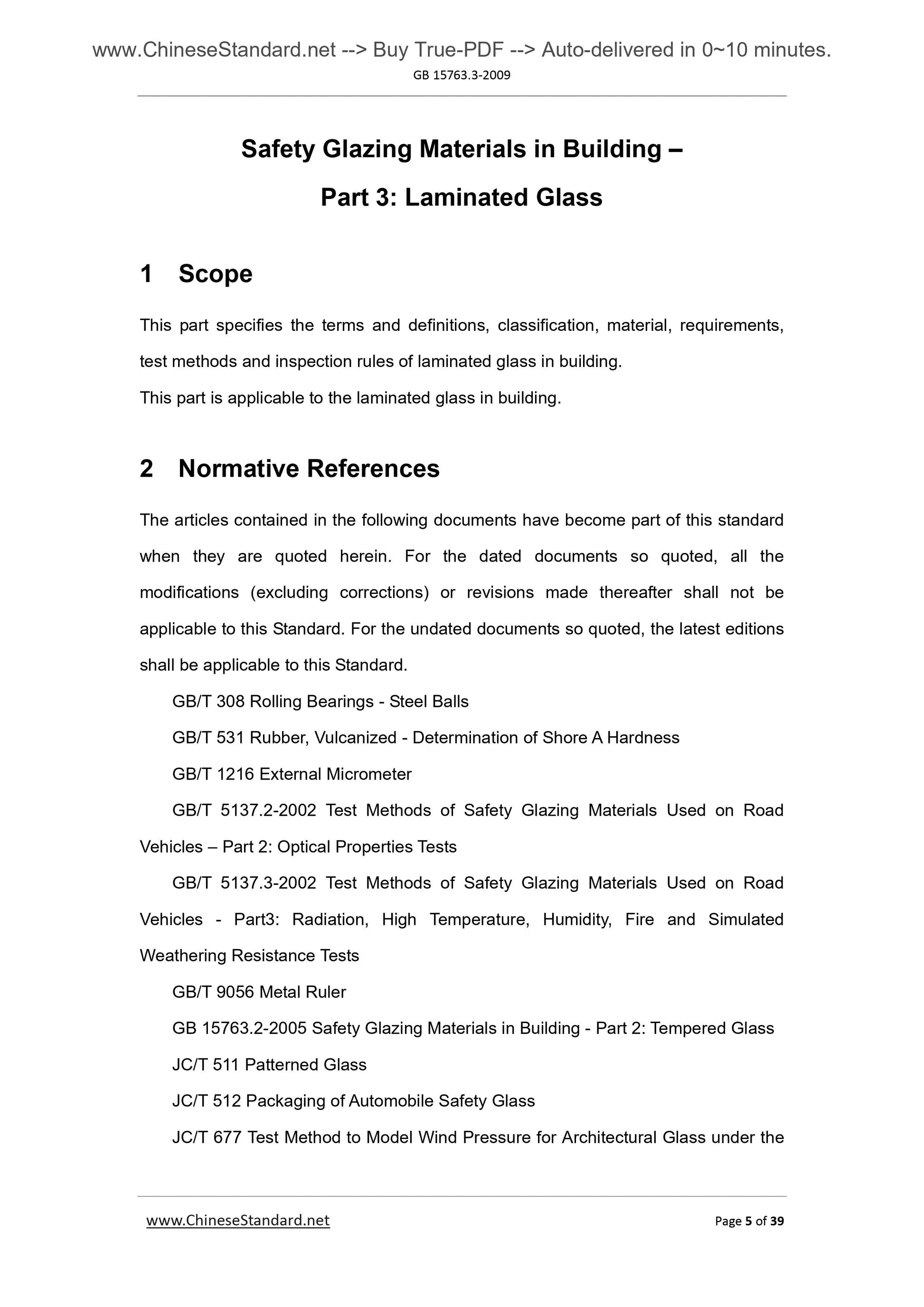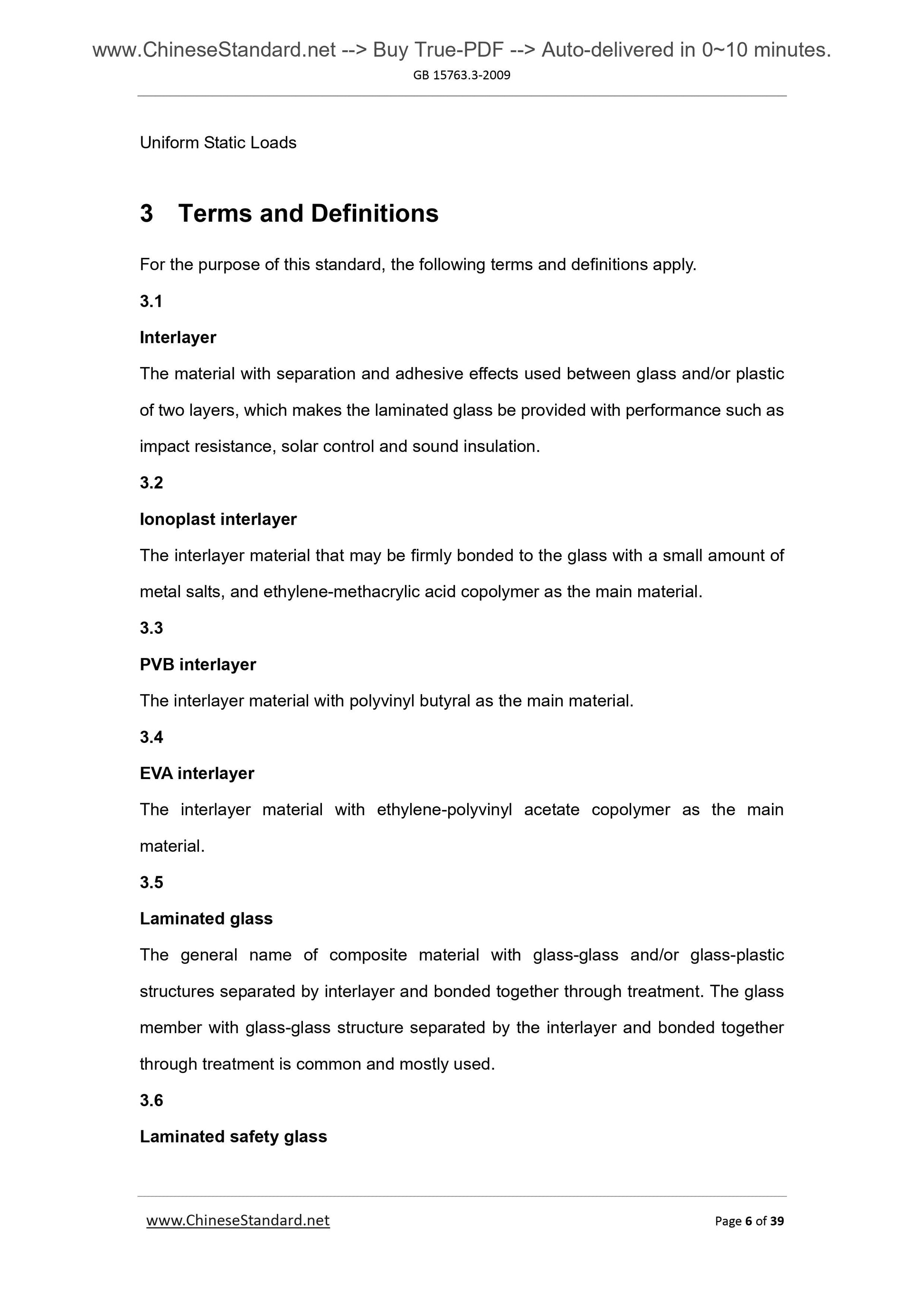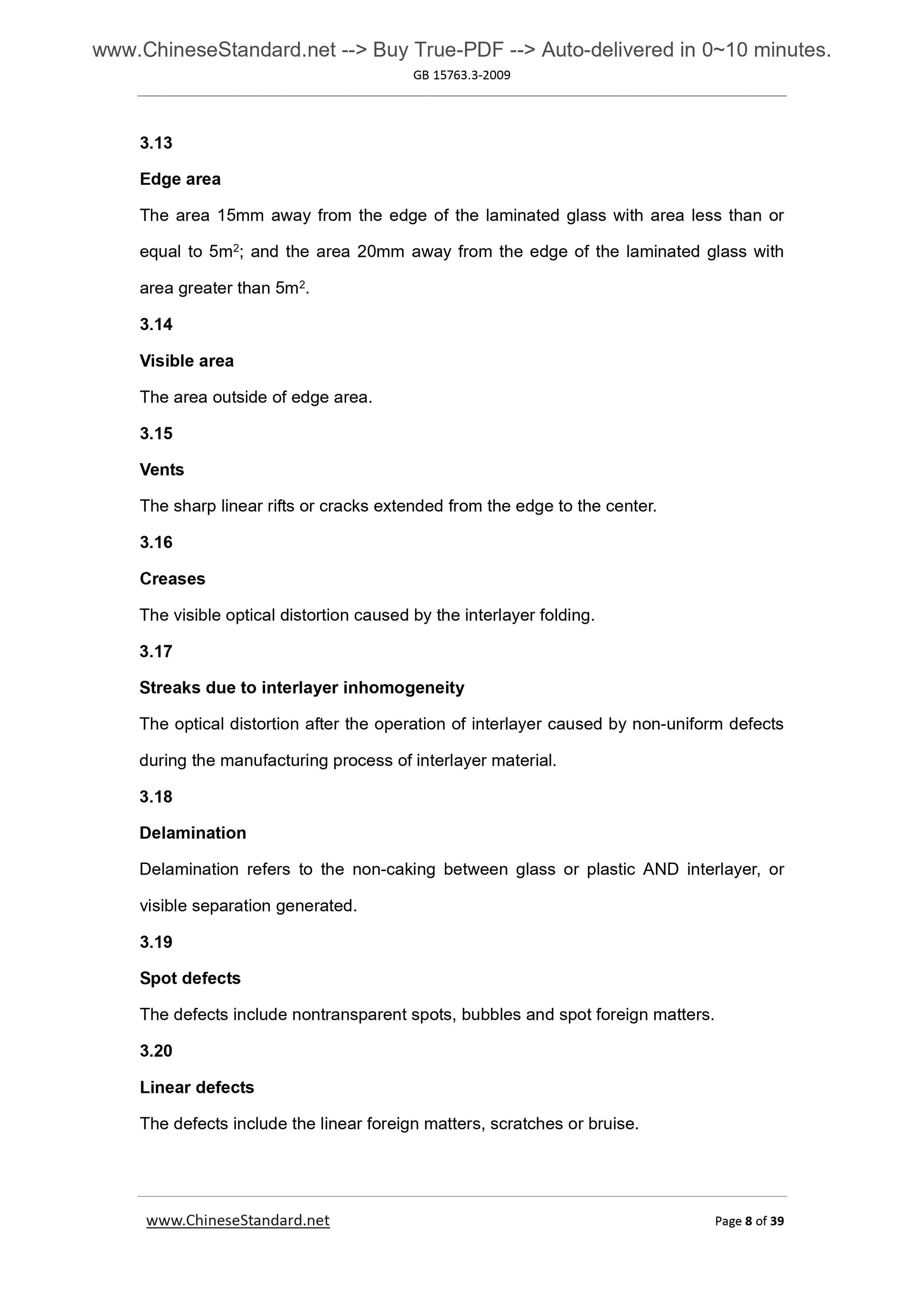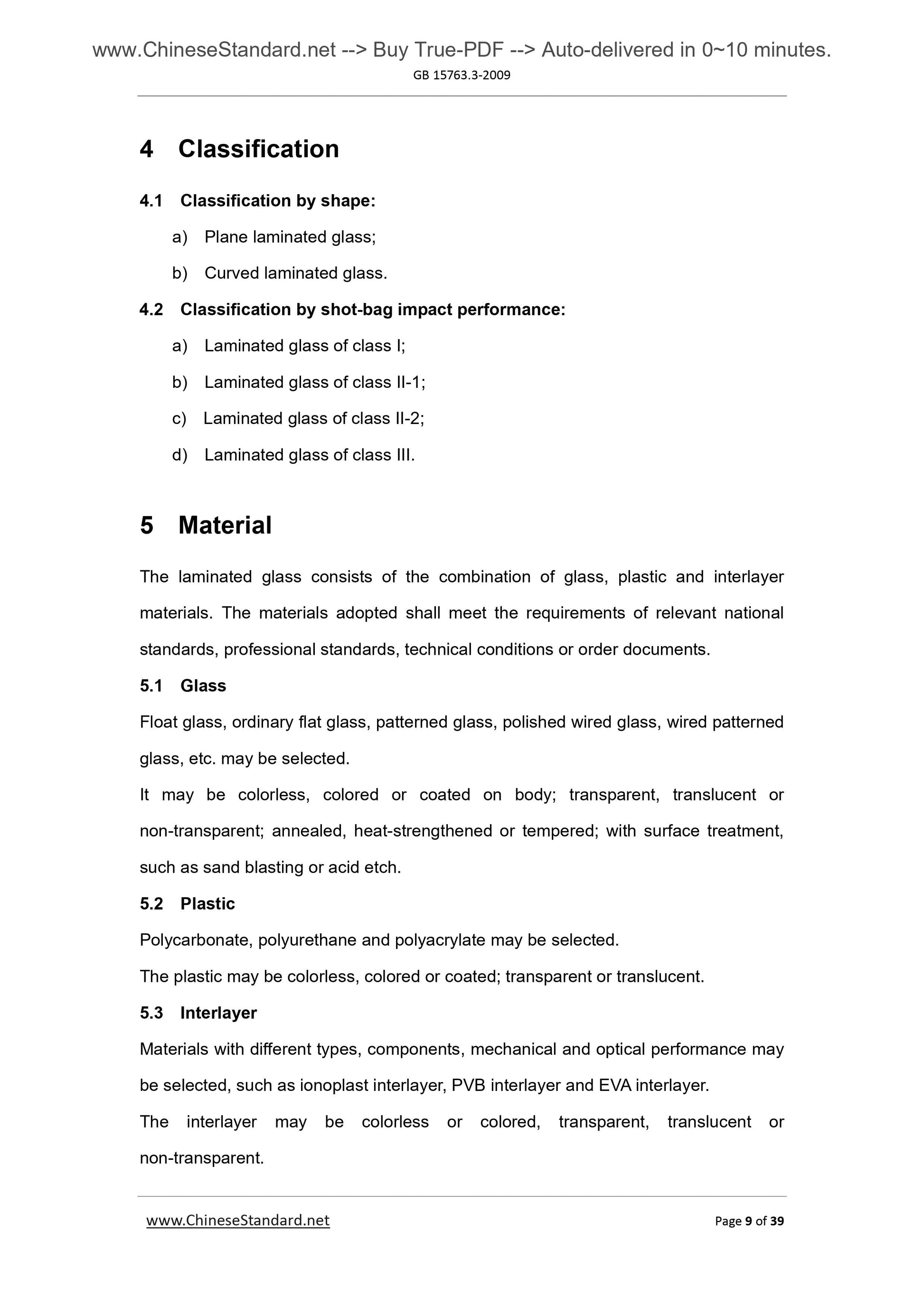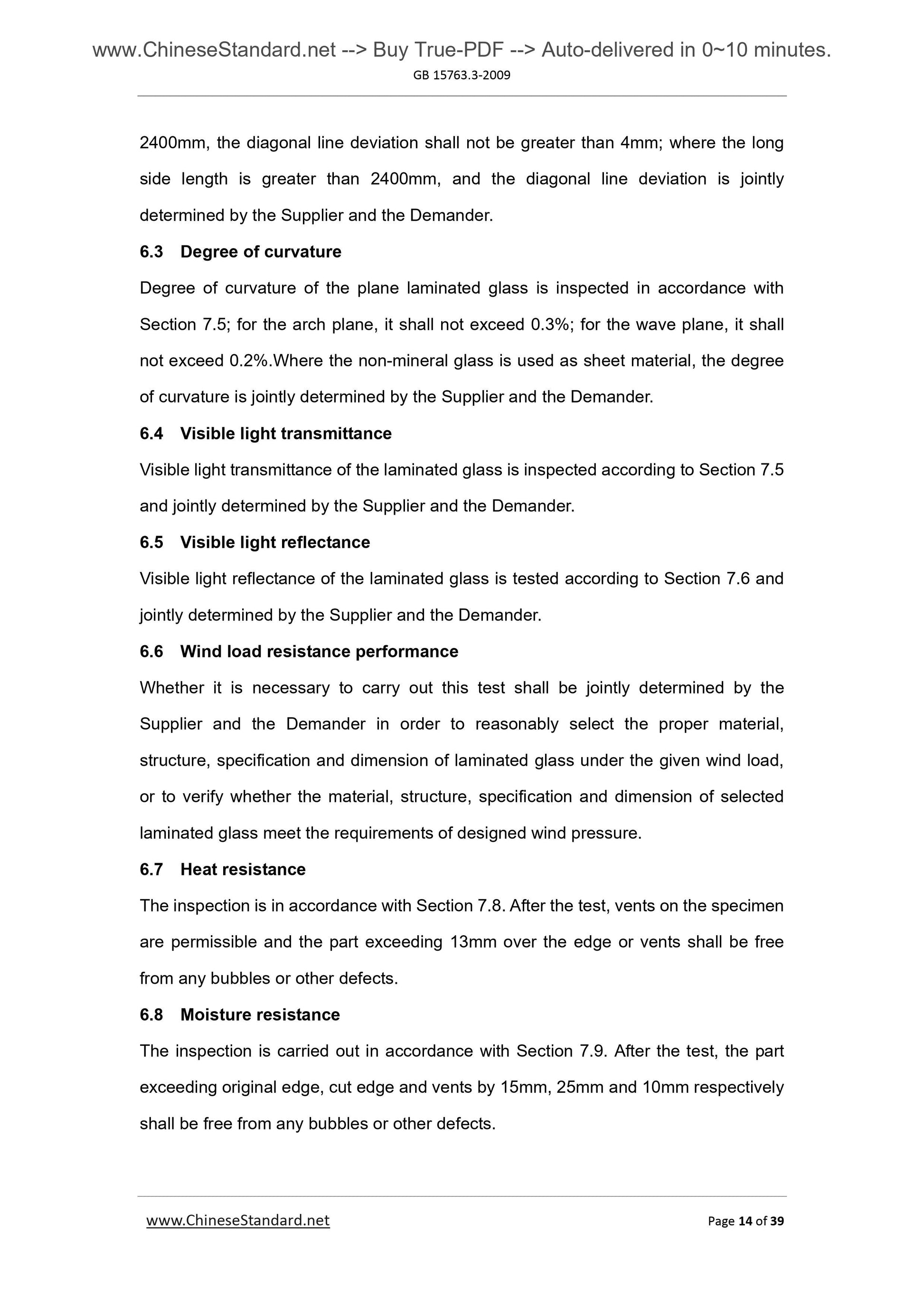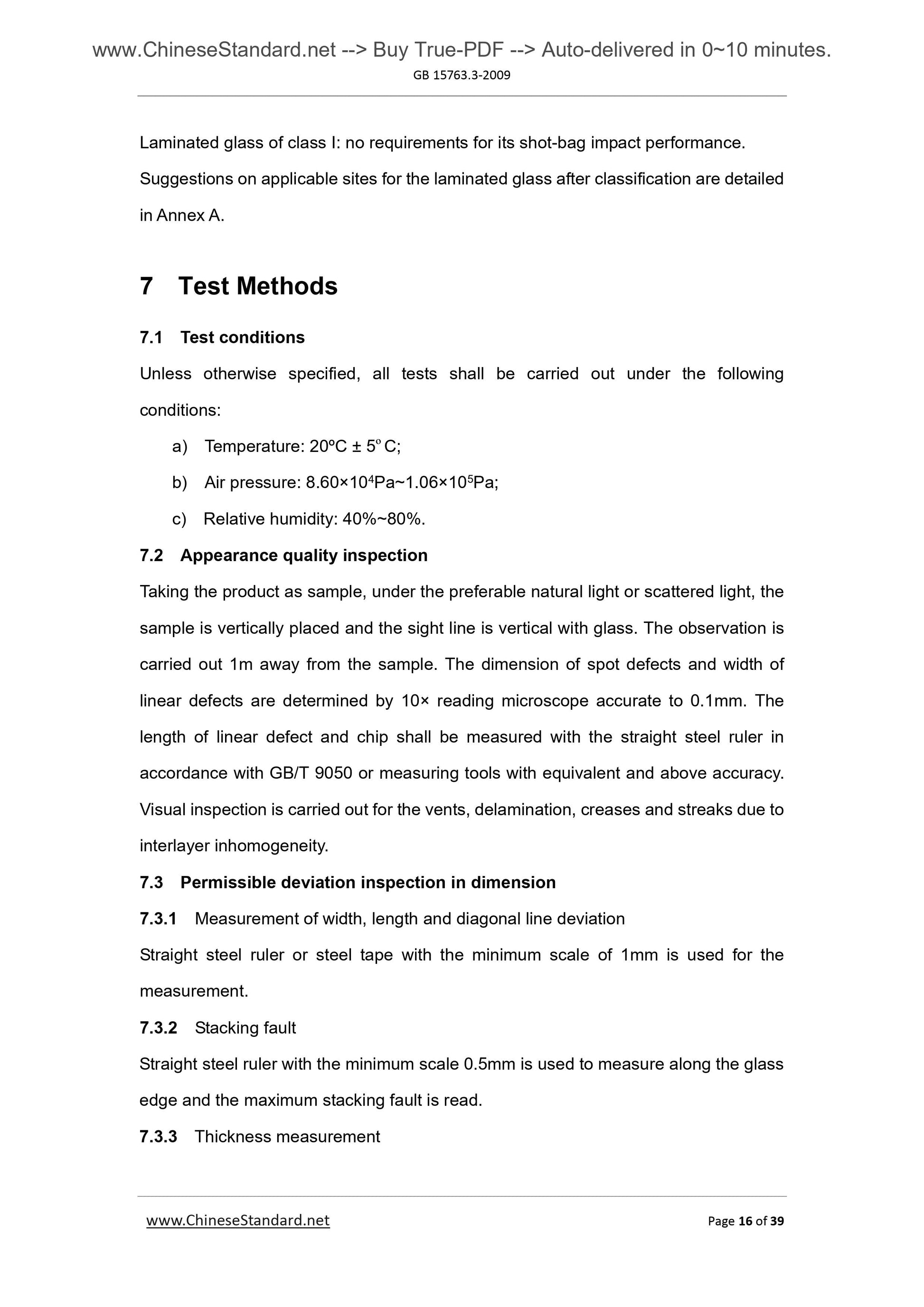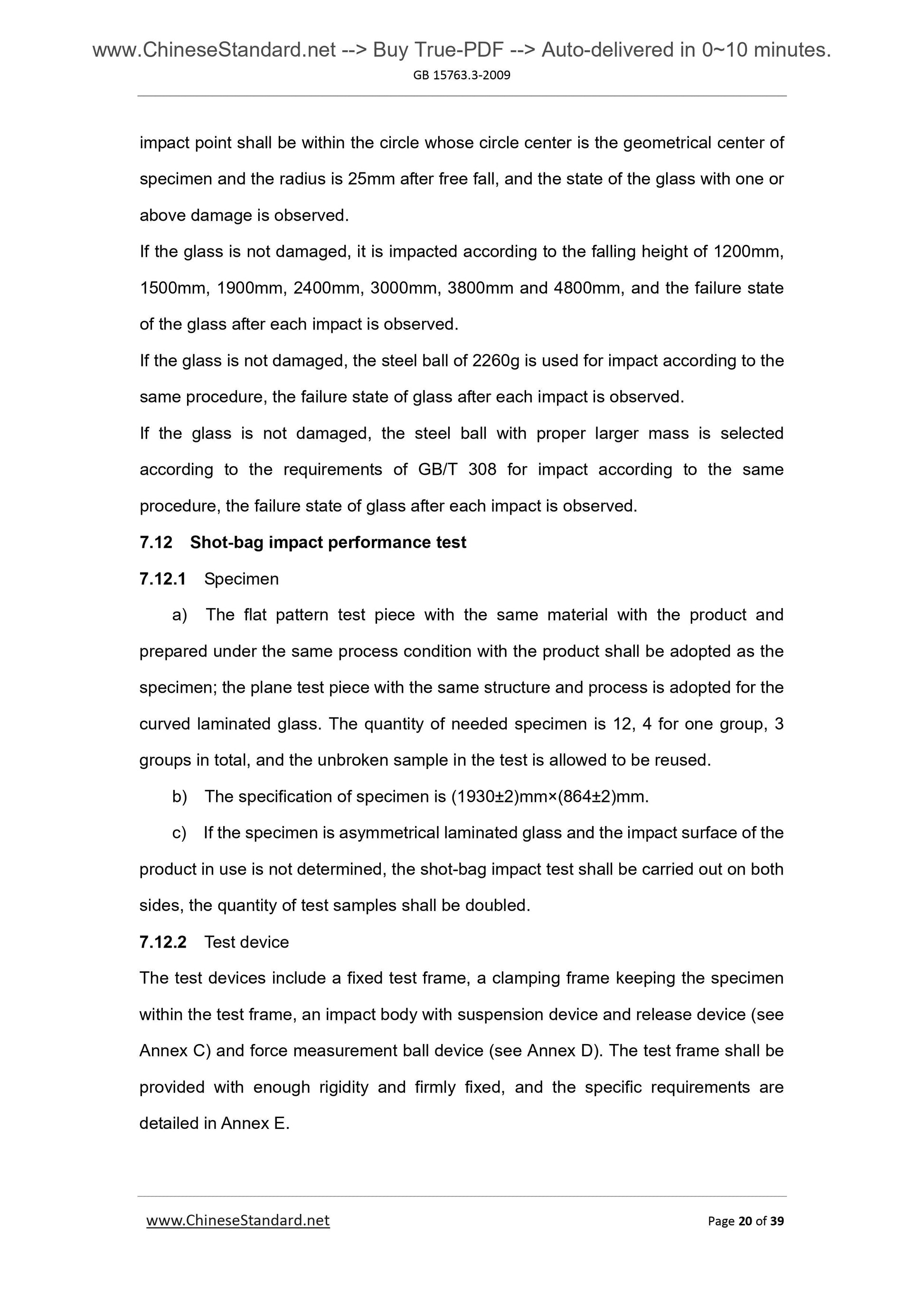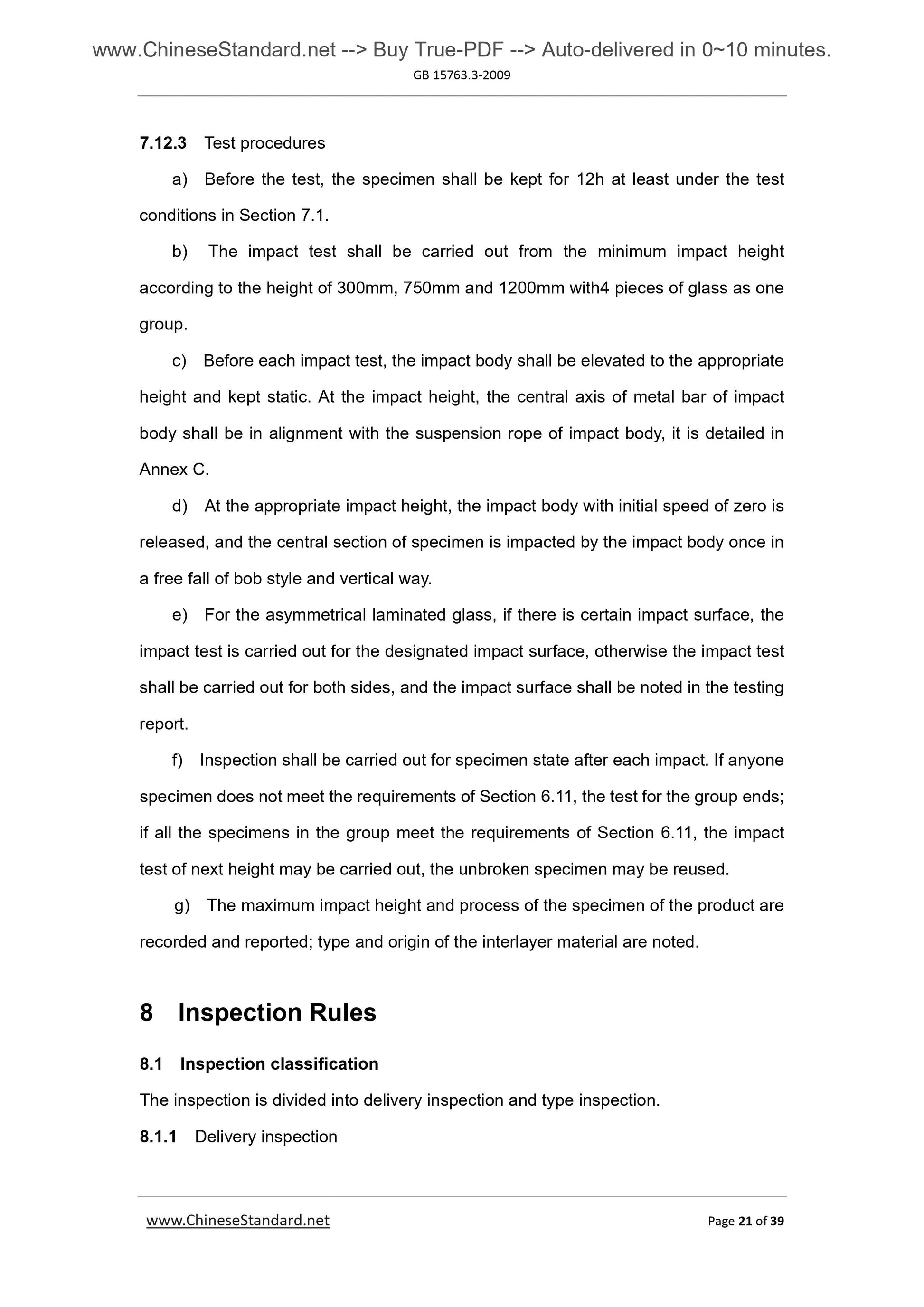1
/
of
12
PayPal, credit cards. Download editable-PDF & invoice in 1 second!
GB 15763.3-2009 English PDF (GB15763.3-2009)
GB 15763.3-2009 English PDF (GB15763.3-2009)
Regular price
$85.00 USD
Regular price
Sale price
$85.00 USD
Unit price
/
per
Shipping calculated at checkout.
Couldn't load pickup availability
Delivery: 3 seconds. Download true-PDF + Invoice.
Get QUOTATION in 1-minute: Click GB 15763.3-2009
Historical versions: GB 15763.3-2009
Preview True-PDF (Reload/Scroll if blank)
GB 15763.3-2009: Safety glazing materials in building -- Part 3: Laminated glass
GB 15763.3-2009
ICS 81.040
Q 33
GB
NATIONAL STANDARD
OF THE PEOPLE’S REPUBLIC OF CHINA
Replacing GB 9962-1999
Safety Glazing Materials in Building - Part 3.
Laminated Glass
ISSUED ON. MARCH 28, 2009
IMPLEMENTED ON. MARCH 1, 2010
Issued by.
General Administration of Quality Supervision, Inspection
and Quarantine of the People’s Republic of China;
Standardization Administration of the People’s Republic of
China
Table of Contents
Foreword ... 3
1 Scope ... 5
2 Normative References ... 5
3 Terms and Definitions ... 6
4 Classification ... 9
5 Material ... 9
6 Requirements ... 10
7 Test Methods ... 16
8 Inspection Rules ... 21
9 Packaging, Marking, Transportation and Storage ... 24
Annex A (Informative) Usage Suggestion on Safety Glazing Materials in Building ... 26
Annex B (Normative) Falling Ball Impact Specimen Support ... 30
Annex C (Normative) Test Equipment for Shot-bag Impact Performance ... 31
Annex D (Normative) Force-measuring Ball ... 35
Annex E (Informative) Frame Calibration for Shot-bag Impact Classification Test ... 36
Foreword
Sections 6.7~6.11 of this part are compulsory, and the rest are voluntary.
"Safety Glazing Materials in Building" (GB 15763) is divided into 4 parts.
- Part 1. Fire-resistant Glass;
- Part 2. Tempered Glass;
- Part 3. Laminated Glass;
- Part 4. Heat Soaked Thermally Tempered Glass.
This is Part 3 of GB 15763.
The consistent degree of this part is not equivalent to “Glass in Building - Laminated
Glass and Laminated Safety Glass - Part 1. Definitions and Description of Component
Parts” (EN ISO 12543-1. 1998), “Glass in Building - Laminated Glass and Laminated
Safety Glass - Part 2. Laminated Safety Glass” (EN ISO 12543-2. 2006), “Glass in
Building - Laminated Glass and Laminated Safety Glass - Part 3. Laminated Glass”
(EN ISO 12543-3. 1998), “Glass in Building - Laminated Glass and Laminated Safety
Glass - Part 4. Test Methods for Durability” (EN ISO 12543-4. 1998), “Glass in
Building - Laminated Glass and Laminated Safety Glass - Part 5. Dimensions and
Edge Finishing” (EN ISO 12543-5. 1998), “Glass in Building - Laminated Glass and
Laminated Safety Glass - Part 6. Appearance” (EN ISO 12543-6. 1998), and “Glass in
Building - Pendulum Test - Impact Test Method and Classification for Flat Glass” (BS
EN 12600. 2002); and this part makes references to “Safety Glazing Materials in
Buildings” (AS/NZS 2208. 1996/Amdt 1. 1999) and “Glazing Materials Used in
Buildings - Safety Performance Specifications and Methods of Test” (ANSI 97.1.
2004).
This part replaces "Laminated Glass" (GB 9962-1999). Compared with "Laminated
Glass" (GB 9962-1999), the main changes in this part are as follows.
- The definition (Section 3.5 in this part) of laminated glass was modified; the
definition (Section 3.6 in this part) of laminated safety glass was added;
- The requirements for “appearance quality” and “permissible dimension
deviation” (Sections 6.1 and 6.2 in this part) were modified;
- The technical index for “radiation resistant performance” (Section 6.9 in this part)
was modified;
- The requirements and test methods for “shot-bag impact performance”
(Sections 6.11 and 7.12 in this part) were modified;
- The performance test methods of “heat resistance test” (Section 7.8 in this part)
were modified;
- The "usage suggestion for safety glazing materials in building" (Annex A in this
part) and "frame calibration of shot-bag impact classification test" (Annex E in this
part) were added.
Annexes B, C and D of this part are normative and Annexes A and E are informative.
This part was proposed by China Building Materials Federation.
This part is under the jurisdiction of National Technical Committee on Glass in Building
of Standardization Administration of China.
Chief drafting organizations of this part. China Building Materials Academy, China
Building Materials Test and Certification Center, and Qinhuangdao Glass Industry
Research and Design Institute.
Participating drafting organizations of this part. Xinyi Glass Holdings Limited, WuXi
XinHui Glass Product Co., Ltd., Beijing WuHua TianBao Glass Co., Ltd., CSG Holding
Co., Ltd., Chengdu Tongda Technology Glass Co., Ltd., Jiangsu Xiuqiang Glasswork
Co., Ltd., Shanghai Yaohua Pilkington Glass Co., Ltd., and Guangdong Jingang
Special Type Glass Co., Ltd..
Chief drafting staffs of this part. Qin Haixia, Zang Shuguang, Wang Wenbiao, Wang
Le, Yang Jianjun, Xu Jinwei, Zeng Xiao, Liu Haibo, Liao Changrong, Zhou Jian, Pan
Wei, Wu Congzhen, and Zhang Jianhua.
The previous editions replaced by this part are as follows.
- GB 9962-1988 and GB 9962-1999.
Safety Glazing Materials in Building –
Part 3. Laminated Glass
1 Scope
This part specifies the terms and definitions, classification, material, requirements,
test methods and inspection rules of laminated glass in building.
This part is applicable to the laminated glass in building.
2 Normative References
The articles contained in the following documents have become part of this standard
when they are quoted herein. For the dated documents so quoted, all the
modifications (excluding corrections) or revisions made thereafter shall not be
applicable to this Standard. For the undated documents so quoted, the latest editions
shall be applicable to this Standard.
GB/T 308 Rolling Bearings - Steel Balls
GB/T 531 Rubber, Vulcanized - Determination of Shore A Hardness
GB/T 1216 External Micrometer
GB/T 5137.2-2002 Test Methods of Safety Glazing Materials Used on Road
Vehicles – Part 2. Optical Properties Tests
GB/T 5137.3-2002 Test Methods of Safety Glazing Materials Used on Road
Vehicles - Part3. Radiation, High Temperature, Humidity, Fire and Simulated
Weathering Resistance Tests
GB/T 9056 Metal Ruler
GB 15763.2-2005 Safety Glazing Materials in Building - Part 2. Tempered Glass
JC/T 511 Patterned Glass
JC/T 512 Packaging of Automobile Safety Glass
JC/T 677 Test Method to Model Wind Pressure for Architectural Glass under the
Uniform Static Loads
3 Terms and Definitions
For the purpose of this standard, the following terms and definitions apply.
3.1
Interlayer
The material with separation and adhesive effects used between glass and/or plastic
of two layers, which makes the laminated glass be provided with performance such as
impact resistance, solar control and sound insulation.
3.2
Ionoplast interlayer
The interlayer material that may be firmly bonded to the glass with a small amount of
metal salts, and ethylene-methacrylic acid copolymer as the main material.
3.3
PVB interlayer
The interlayer material with polyvinyl butyral as the main material.
3.4
EVA interlayer
The interlayer material with ethylene-polyvinyl acetate copolymer as the main
material.
3.5
Laminated glass
The general name of composite material with glass-glass and/or glass-plastic
structures separated by interlayer and bonded together through treatment. The glass
member with glass-glass structure separated by the interlayer and bonded together
through treatment is common and mostly used.
3.6
Laminated safety glass
3.13
Edge area
The area 15mm away from the edge of the laminated glass with area less than or
equal to 5m2; and the area 20mm away from the edge of the laminated glass with
area greater than 5m2.
3.14
Visible area
The area outside of edge area.
3.15
Vents
The...
Get QUOTATION in 1-minute: Click GB 15763.3-2009
Historical versions: GB 15763.3-2009
Preview True-PDF (Reload/Scroll if blank)
GB 15763.3-2009: Safety glazing materials in building -- Part 3: Laminated glass
GB 15763.3-2009
ICS 81.040
Q 33
GB
NATIONAL STANDARD
OF THE PEOPLE’S REPUBLIC OF CHINA
Replacing GB 9962-1999
Safety Glazing Materials in Building - Part 3.
Laminated Glass
ISSUED ON. MARCH 28, 2009
IMPLEMENTED ON. MARCH 1, 2010
Issued by.
General Administration of Quality Supervision, Inspection
and Quarantine of the People’s Republic of China;
Standardization Administration of the People’s Republic of
China
Table of Contents
Foreword ... 3
1 Scope ... 5
2 Normative References ... 5
3 Terms and Definitions ... 6
4 Classification ... 9
5 Material ... 9
6 Requirements ... 10
7 Test Methods ... 16
8 Inspection Rules ... 21
9 Packaging, Marking, Transportation and Storage ... 24
Annex A (Informative) Usage Suggestion on Safety Glazing Materials in Building ... 26
Annex B (Normative) Falling Ball Impact Specimen Support ... 30
Annex C (Normative) Test Equipment for Shot-bag Impact Performance ... 31
Annex D (Normative) Force-measuring Ball ... 35
Annex E (Informative) Frame Calibration for Shot-bag Impact Classification Test ... 36
Foreword
Sections 6.7~6.11 of this part are compulsory, and the rest are voluntary.
"Safety Glazing Materials in Building" (GB 15763) is divided into 4 parts.
- Part 1. Fire-resistant Glass;
- Part 2. Tempered Glass;
- Part 3. Laminated Glass;
- Part 4. Heat Soaked Thermally Tempered Glass.
This is Part 3 of GB 15763.
The consistent degree of this part is not equivalent to “Glass in Building - Laminated
Glass and Laminated Safety Glass - Part 1. Definitions and Description of Component
Parts” (EN ISO 12543-1. 1998), “Glass in Building - Laminated Glass and Laminated
Safety Glass - Part 2. Laminated Safety Glass” (EN ISO 12543-2. 2006), “Glass in
Building - Laminated Glass and Laminated Safety Glass - Part 3. Laminated Glass”
(EN ISO 12543-3. 1998), “Glass in Building - Laminated Glass and Laminated Safety
Glass - Part 4. Test Methods for Durability” (EN ISO 12543-4. 1998), “Glass in
Building - Laminated Glass and Laminated Safety Glass - Part 5. Dimensions and
Edge Finishing” (EN ISO 12543-5. 1998), “Glass in Building - Laminated Glass and
Laminated Safety Glass - Part 6. Appearance” (EN ISO 12543-6. 1998), and “Glass in
Building - Pendulum Test - Impact Test Method and Classification for Flat Glass” (BS
EN 12600. 2002); and this part makes references to “Safety Glazing Materials in
Buildings” (AS/NZS 2208. 1996/Amdt 1. 1999) and “Glazing Materials Used in
Buildings - Safety Performance Specifications and Methods of Test” (ANSI 97.1.
2004).
This part replaces "Laminated Glass" (GB 9962-1999). Compared with "Laminated
Glass" (GB 9962-1999), the main changes in this part are as follows.
- The definition (Section 3.5 in this part) of laminated glass was modified; the
definition (Section 3.6 in this part) of laminated safety glass was added;
- The requirements for “appearance quality” and “permissible dimension
deviation” (Sections 6.1 and 6.2 in this part) were modified;
- The technical index for “radiation resistant performance” (Section 6.9 in this part)
was modified;
- The requirements and test methods for “shot-bag impact performance”
(Sections 6.11 and 7.12 in this part) were modified;
- The performance test methods of “heat resistance test” (Section 7.8 in this part)
were modified;
- The "usage suggestion for safety glazing materials in building" (Annex A in this
part) and "frame calibration of shot-bag impact classification test" (Annex E in this
part) were added.
Annexes B, C and D of this part are normative and Annexes A and E are informative.
This part was proposed by China Building Materials Federation.
This part is under the jurisdiction of National Technical Committee on Glass in Building
of Standardization Administration of China.
Chief drafting organizations of this part. China Building Materials Academy, China
Building Materials Test and Certification Center, and Qinhuangdao Glass Industry
Research and Design Institute.
Participating drafting organizations of this part. Xinyi Glass Holdings Limited, WuXi
XinHui Glass Product Co., Ltd., Beijing WuHua TianBao Glass Co., Ltd., CSG Holding
Co., Ltd., Chengdu Tongda Technology Glass Co., Ltd., Jiangsu Xiuqiang Glasswork
Co., Ltd., Shanghai Yaohua Pilkington Glass Co., Ltd., and Guangdong Jingang
Special Type Glass Co., Ltd..
Chief drafting staffs of this part. Qin Haixia, Zang Shuguang, Wang Wenbiao, Wang
Le, Yang Jianjun, Xu Jinwei, Zeng Xiao, Liu Haibo, Liao Changrong, Zhou Jian, Pan
Wei, Wu Congzhen, and Zhang Jianhua.
The previous editions replaced by this part are as follows.
- GB 9962-1988 and GB 9962-1999.
Safety Glazing Materials in Building –
Part 3. Laminated Glass
1 Scope
This part specifies the terms and definitions, classification, material, requirements,
test methods and inspection rules of laminated glass in building.
This part is applicable to the laminated glass in building.
2 Normative References
The articles contained in the following documents have become part of this standard
when they are quoted herein. For the dated documents so quoted, all the
modifications (excluding corrections) or revisions made thereafter shall not be
applicable to this Standard. For the undated documents so quoted, the latest editions
shall be applicable to this Standard.
GB/T 308 Rolling Bearings - Steel Balls
GB/T 531 Rubber, Vulcanized - Determination of Shore A Hardness
GB/T 1216 External Micrometer
GB/T 5137.2-2002 Test Methods of Safety Glazing Materials Used on Road
Vehicles – Part 2. Optical Properties Tests
GB/T 5137.3-2002 Test Methods of Safety Glazing Materials Used on Road
Vehicles - Part3. Radiation, High Temperature, Humidity, Fire and Simulated
Weathering Resistance Tests
GB/T 9056 Metal Ruler
GB 15763.2-2005 Safety Glazing Materials in Building - Part 2. Tempered Glass
JC/T 511 Patterned Glass
JC/T 512 Packaging of Automobile Safety Glass
JC/T 677 Test Method to Model Wind Pressure for Architectural Glass under the
Uniform Static Loads
3 Terms and Definitions
For the purpose of this standard, the following terms and definitions apply.
3.1
Interlayer
The material with separation and adhesive effects used between glass and/or plastic
of two layers, which makes the laminated glass be provided with performance such as
impact resistance, solar control and sound insulation.
3.2
Ionoplast interlayer
The interlayer material that may be firmly bonded to the glass with a small amount of
metal salts, and ethylene-methacrylic acid copolymer as the main material.
3.3
PVB interlayer
The interlayer material with polyvinyl butyral as the main material.
3.4
EVA interlayer
The interlayer material with ethylene-polyvinyl acetate copolymer as the main
material.
3.5
Laminated glass
The general name of composite material with glass-glass and/or glass-plastic
structures separated by interlayer and bonded together through treatment. The glass
member with glass-glass structure separated by the interlayer and bonded together
through treatment is common and mostly used.
3.6
Laminated safety glass
3.13
Edge area
The area 15mm away from the edge of the laminated glass with area less than or
equal to 5m2; and the area 20mm away from the edge of the laminated glass with
area greater than 5m2.
3.14
Visible area
The area outside of edge area.
3.15
Vents
The...
Share













